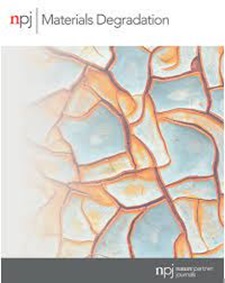Mechanistic elucidation of the molecular weight dependence of corrosion inhibition afforded by polyetherimide coatings
IF 7.6
2区 材料科学
Q1 MATERIALS SCIENCE, MULTIDISCIPLINARY
引用次数: 0
Abstract
Corrosion of critical metal components exacts a heavy toll in terms of maintenance and replacement costs and damage to ecosystems upon failure. Polymeric barrier coatings protect against corrosion; however, design principles for modulating polymer structure to improve corrosion inhibition remain contested and elusive. Here, we examine molecular-weight-dependent differences in the efficacy of corrosion inhibition on aluminum substrates afforded by polyetherimide (PEI) coatings. Analyses of coated substrates evidence a clear trend denoting improved corrosion inhibition for higher weighted-average molecular weight (MW) PEI. The more rigid and entangled macromolecular network of higher-MW variants exhibit stable impedance values, |Z|0.01 Hz ca. 1010 Ω/cm2, upon extended immersion in brine media, whereas lower-MW variants are readily hydrated and disentangled resulting in a significant reduction in impedance values. Results illuminate mechanistic understanding of molecular-weight-dependence in corrosion inhibition, advance a framework for considering the dynamical evolution of secondary structure, and exemplify generalizable design principles for corrosion inhibition.

从机理上阐明聚醚酰亚胺涂层的缓蚀作用与分子量的关系
关键金属部件的腐蚀会造成重大损失,包括维护和更换成本,以及失效后对生态系统的破坏。聚合阻挡涂层可以防止腐蚀;然而,调节聚合物结构以改善缓蚀效果的设计原则仍然存在争议,难以捉摸。在此,我们研究了聚醚酰亚胺(PEI)涂层对铝基材的缓蚀效果随分子量而产生的差异。对涂层基材的分析表明,加权平均分子量(MW)较高的 PEI 具有明显的缓蚀效果。在盐水介质中长期浸泡后,高分子量变体的大分子网络更加坚硬和缠结,表现出稳定的阻抗值(|Z|0.01 Hz,约为 1010 Ω/cm2),而低分子量变体则很容易水化和分散,导致阻抗值显著降低。研究结果阐明了对缓蚀中分子量依赖性的机理理解,推进了考虑二级结构动态演变的框架,并体现了可推广的缓蚀设计原则。
本文章由计算机程序翻译,如有差异,请以英文原文为准。
求助全文
约1分钟内获得全文
求助全文
来源期刊

npj Materials Degradation
MATERIALS SCIENCE, MULTIDISCIPLINARY-
CiteScore
7.80
自引率
7.80%
发文量
86
审稿时长
6 weeks
期刊介绍:
npj Materials Degradation considers basic and applied research that explores all aspects of the degradation of metallic and non-metallic materials. The journal broadly defines ‘materials degradation’ as a reduction in the ability of a material to perform its task in-service as a result of environmental exposure.
The journal covers a broad range of topics including but not limited to:
-Degradation of metals, glasses, minerals, polymers, ceramics, cements and composites in natural and engineered environments, as a result of various stimuli
-Computational and experimental studies of degradation mechanisms and kinetics
-Characterization of degradation by traditional and emerging techniques
-New approaches and technologies for enhancing resistance to degradation
-Inspection and monitoring techniques for materials in-service, such as sensing technologies
 求助内容:
求助内容: 应助结果提醒方式:
应助结果提醒方式:


